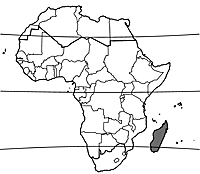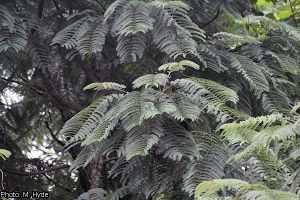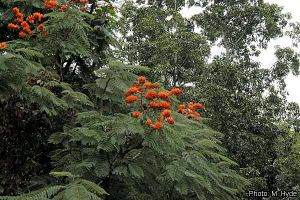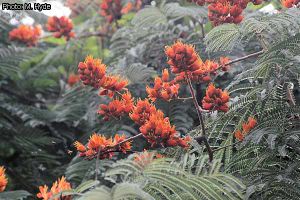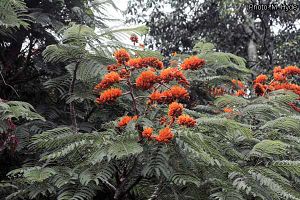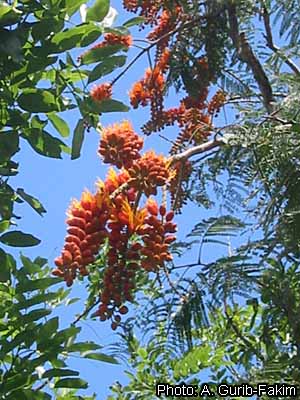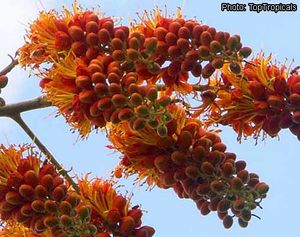Colvillea racemosa (PROTA)
Introduction |
| General importance | |
| Geographic coverage Africa | |
| Geographic coverage World | |
| Timber | |
| Fuel | |
| Ornamental | |
| Conservation status | |
Colvillea racemosa Bojer ex Hook.
- Protologue: Bot. Mag. 61: t. 3325–3326 (1834).
- Family: Caesalpiniaceae (Leguminosae - Caesalpinioideae)
- Chromosome number: 2n = 26, 28
Vernacular names
- Colville’s glory tree, whip tree (En).
- Flamboyant d’avril, gloire de Colville (Fr).
Origin and geographic distribution
Colvillea racemosa is endemic to western Madagascar, where it occurs in the north near Antsiranana, and from the Bemaraha Plateau to the south.
Uses
The wood, known as ‘sarongaza’, is used for posts, carpentry, shuttering, fences and veneer. It is suitable for light joinery, interior trim, furniture, boxes and crates. The boles are used to make dug-out canoes. Colvillea racemosa is planted as an ornamental tree because of its bright orange flowers and delicate foliage, also in several tropical countries outside Madagascar.
Properties
The wood is yellowish white to greyish yellow. The grain is straight, texture coarse. The wood is moderately lightweight, with a density of 410–580 kg/m³ at 12% moisture content, and soft. It air dries rapidly and without much defects when it is properly stacked. The rates of shrinkage are moderate, from green to oven dry about 3.8% radial and 7.3% tangential. At 12% moisture content, the modulus of rupture is about 124 N/mm², modulus of elasticity 18,300 N/mm², compression parallel to grain 40 N/mm² and Chalais-Meudon side hardness 2.8. The veneering properties are satisfactory. The wood is not durable, but fairly easy to impregnate with preservatives.
Description
- Deciduous, small to medium-sized tree up to 20(–30) m tall; bole usually cylindrical and straight, sometimes slightly sinuous, up to 90(–100) cm in diameter; bark surface finely grooved, peeling off in thin strips, pale grey, with many lenticels, inner bark green; crown elongate, with irregularly spreading or pendulous branches.
- Leaves alternate, bipinnately compound with ( 6–)9–16 pairs of pinnae; stipules small, caducous; petiole 3–8.5 cm long, swollen at base, rachis up to 30 cm long, grooved and greyish hairy; leaflets opposite, numerous, nearly sessile, oblong, (0.5–)1–2 cm long, slightly asymmetrical, short-hairy.
- Inflorescence a large, terminal panicle c. 50 cm long, with pendulous branches up to 40 cm long, short-hairy, many-flowered.
- Flowers bisexual, zygomorphic, 5-merous, bright orange with orange-red petals; pedicel 0.5–1 cm long; calyx 2–2.5 cm long, leathery, with 4 short lobes in lower part of flower and 1 long lobe in upper part; petals free, the lower one up to 1.5 cm long with strongly inrolled margins, lateral two rhombic, up to 1.5 cm long, upper two narrowly rhombic, up to 3 cm long; stamens 10, free, 2.5–4.5 cm long, curved outwards from the top of the flower; ovary superior, elongate, flattened, c. 1.5 cm long, 1-celled, style slender, 4.5–5 cm long.
- Fruit a narrowly oblong, flattened, pendulous pod 25–35 cm × 4–7 cm, glabrous, dehiscing along one side, 12–20-seeded.
- Seeds oblong-obovate, flattened, c. 1.5 cm × 1 cm, pale brown mottled with darker brown.
- Seedling with hypogeal germination.
Other botanical information
Young trees grow fairly rapidly. A mean annual bole diameter increment of 7–14 mm has been reached during the first 10 years after planting. Colvillea racemosa flowers from December to March(–April). The flowers, which produce abundantly nectar, are pollinated by sunbirds. They are often eaten by lemurs. Fruits ripen about 6 months after flowering.
Colvillea comprises a single species. It is related to Delonix and Lemuropisum.
Ecology
Colvillea racemosa occurs in deciduous woodland and seasonally dry forest on sandy soils, up to 300 m altitude. The mean annual rainfall in its area of distribution is up to 700(–1200) mm, with 7–9 dry months, and the mean annual temperature 24.5–27°C.
Management
The fruits are collected from the tree or the ground when they have become dry and blackish, from May to July. The seeds are extracted manually and non-viable seeds are separated by floating in water. Viable seeds are dried in the sun. The weight of 1000 seeds is 275–400 g. The seeds can be stored for up to 4 years, when still a germination rate of 50–70% can be reached. It is recommended to submerge them in boiling water before sowing. When seedlings are raised in the nursery, they can be planted into the field after 6–12 months when they are 50–100 cm tall. Clipping the lateral roots is advised. Direct sowing into the field is also practised. Propagation by cuttings has been successful.
Genetic resources
Colvillea racemosa is included in the IUCN Red List, where it is considered to be at lower risk, although near threatened. It is locally common, but its natural habitat of deciduous woodland is strongly fragmented.
Prospects
Tests with Colvillea racemosa in Madagascar showed positive results. The wood fulfils the requirements for technical processing and has characteristics rendering it suitable for economic exploitation, e.g. for veneer production. Colvillea racemosa has good colonizing potential, and reforestation can be achieved by direct sowing. As such, it seems to have good potential for reforestation in regions with seasonally dry forest in Madagascar. It deserves wider application as an ornamental tree.
Major references
- Blaser, J., Rajoelison, G., Tsiza, G., Rajemison, M., Rabevohitra, R., Randrianjafy, H., Razafindrianilana, N., Rakotovao, G. & Comtet, S., 1993. Choix des essences pour la sylviculture à Madagascar. Akon’ny Ala: Bulletin du Département des Eaux et Forêts 12–13. 166 pp.
- CFPF (Centre de Formation Professionelle Forestière), 2008. Fiches techniques: version francaise. Centre de Formation Professionelle Forestière, Morondova, Madagascar. 14 pp.
- du Puy, D.J., Labat, J.N., Rabevohitra, R., Villiers, J.-F., Bosser, J. & Moat, J., 2002. The Leguminosae of Madagascar. Royal Botanic Gardens, Kew, Richmond, United Kingdom. 750 pp.
- Rakotovao, G., Rabevohitra, R., Gerard, J., Détienne, P. & Collas de Chatelperron, P., en préparation. Atlas des bois de Madagascar. FOFIFA-DRFP, Antananarivo, Madagascar.
- Randrianasolo, J., 1992. La germination de sarongaza: Colvillea racemosa (Césalpiniacées). Fiche technique du Centre de Formation professionnelle forestière de Morondava 25: 9.
Other references
- du Puy, D.J., Phillipson, P.B. & Rabevohitra, R., 1995. The genus Delonix (Leguminosae: Caesalpinioideae: Caesalpinieae) in Madagascar. Kew Bulletin 50(3): 445–475.
- Randrianasolo, J., Rakotovao, P., Deleporte, P., Rarivoson, C., Sorg, J.-P. & Rohner, U., 1996. Local tree species in the tree nursery. In: Ganzhorn, J.U. & Sorg, J.P. (Editors). Ecology and economy of a tropical dry forest in Madagascar. Primate Report 46–1. German Primate Center, Göttingen, Germany. pp. 117–132.
- World Conservation Monitoring Centre, 1998. Colvillea racemosa. In: IUCN. 2009 IUCN Red List of Threatened Species. [Internet] http://www.iucnredlist.org. March 2009.
Author(s)
- R.H.M.J. Lemmens, PROTA Network Office Europe, Wageningen University, P.O. Box 341, 6700 AH Wageningen, Netherlands
Correct citation of this article
Lemmens, R.H.M.J., 2010. Colvillea racemosa Bojer. [Internet] Record from PROTA4U. Lemmens, R.H.M.J., Louppe, D. & Oteng-Amoako, A.A. (Editors). PROTA (Plant Resources of Tropical Africa / Ressources végétales de l’Afrique tropicale), Wageningen, Netherlands.
Accessed 6 March 2025.
- See the Prota4U database.

